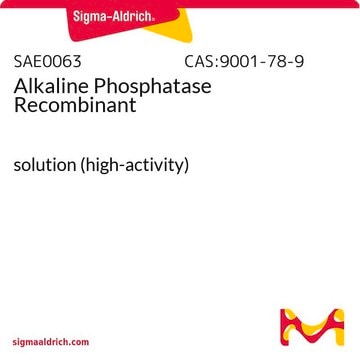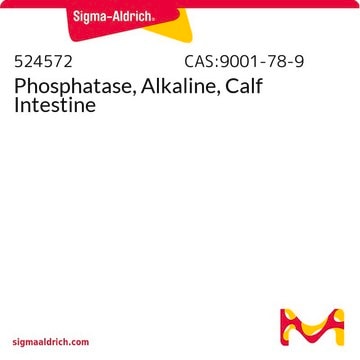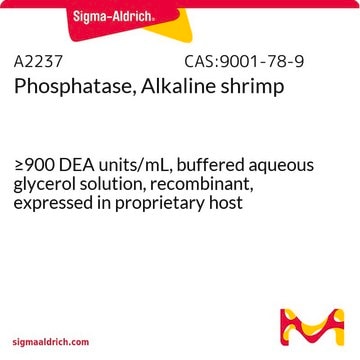P8361
Phosphatase, Alkaline bovine
recombinant, expressed in Pichia pastoris, ≥4000 units/mg protein
Synonym(s):
Orthophosphoric-monoester phosphohydrolase (alkaline optimum)
Sign Into View Organizational & Contract Pricing
All Photos(1)
About This Item
Recommended Products
recombinant
expressed in Pichia pastoris
form
solid
specific activity
≥4000 units/mg protein
mol wt
apparent mol wt 160 kDa
storage temp.
2-8°C
Related Categories
Application
Alkaline phosphatase is used for conjugation to antibodies and other proteins for ELISA, Western blotting, and histochemical detection. It is routinely used to dephosphorylate proteins and nucleic acids. It may be used for protein labeling when high sensitivity is required. Alkaline phosphatase may be also be used to dephosphorylate the 5′-termini of DNA or RNA to prevent self-ligation. DNA or RNA can also be tagged with radiolabeled phosphate (via T4 polynucleotide kinase) after dephosphorylation with alkaline phosphatase. Product P8361 has been used to dephosphorylate Dishevelled (Dvl) , which is a key component in the Wnt/β-catenin signaling pathway.
An assay, using this ALP enzyme, was developed to assess the cryoprotective activity of two proteins CRP-1 and CRP-2. The enzyme has been used for inhibitory studies of cyclic nucleotide analogs that inhibit prostatic acid phosphatase using a fluorogenic assay. It is commonly used as a "reporter" in detection systems, in which it is conjugated to a protein (antibody, streptavidin, etc.) that specifically recognizes a target molecule. Alkaline phosphatase has also been used to dephosphorylate casein.
The product is manufactured without the use of any animal source materials during fermentation or purification.
Biochem/physiol Actions
Alkaline phosphatase dephosphorylates proteins and nucleic acids.
Alkaline phosphatase is a dimer consisting of two equal subunits. The enzyme is a glycoprotein containing approximately 12% carbohydrate (6% hexoses and 6% other neutral sugars). Each molecule of alkaline phosphatase contains four zinc atoms and four disulfide bridges. Maximal activity with alkaline phosphatase is achieved in the presence of magnesium. It catalyzes the hydrolysis of phosphate monoesters such as p-nitrophenyl phosphate, phenyl phosphate, phenolphthalein phosphate, α-glycerol phosphate, β-glycerol phosphate, 2-phosphorylglycerate, triosephosphate, glucose-6-phosphate, glucose 1-phosphate, fructose 1-phosphate, fructose 6-phosphate, adenosine 5-phosphate adenosine 3-phosphate, phosphoenolpyruvate, and β-nicotinamide adenine dinucleotide phosphate. Arsenate, cysteine, iodine, inorganic phosphate, pyrophosphate, diisopropyl phosphate, triphenylphosphate, diisopropyl fluorophosphate, and L-phenylalanine are some of the strong inhibitors of alkaline phosphatase. The enzyme is most stable in the pH range 7.5-9.5.2. The pH optimum for enzymatic activity is pH 8-10.
Unit Definition
One DEA unit will hydrolyze 1 μmole of 4-nitrophenyl phosphate per minute at pH 9.8 at 37 °C.
Signal Word
Danger
Hazard Statements
Precautionary Statements
Hazard Classifications
Resp. Sens. 1
Storage Class Code
11 - Combustible Solids
WGK
WGK 1
Flash Point(F)
Not applicable
Flash Point(C)
Not applicable
Personal Protective Equipment
dust mask type N95 (US), Eyeshields, Gloves
Certificates of Analysis (COA)
Search for Certificates of Analysis (COA) by entering the products Lot/Batch Number. Lot and Batch Numbers can be found on a product’s label following the words ‘Lot’ or ‘Batch’.
Already Own This Product?
Find documentation for the products that you have recently purchased in the Document Library.
Customers Also Viewed
The enzymic dephosphorylation of casein fractions in the presence of 0-18 labelled water.
E B KALAN et al.
Archives of biochemistry and biophysics, 85, 273-275 (1959-11-01)
The activation of alkaline phosphatase by effector molecules. A combined kinetic and hydrodynamic study.
H Neumann et al.
European journal of biochemistry, 109(2), 475-480 (1980-08-01)
Ondrej Bernatik et al.
The Journal of biological chemistry, 286(12), 10396-10410 (2011-02-03)
Dishevelled (Dvl) is a key component in the Wnt/β-catenin signaling pathway. Dvl can multimerize to form dynamic protein aggregates, which are required for the activation of downstream signaling. Upon pathway activation by Wnts, Dvl becomes phosphorylated to yield phosphorylated and
High-throughput screen identifies cyclic nucleotide analogs that inhibit prostatic acid phosphatase.
Eric S McCoy et al.
Journal of biomolecular screening, 18(4), 481-489 (2012-11-30)
The secretory and transmembrane isoforms of prostatic acid phosphatase (PAP) can dephosphorylate extracellular adenosine 5'-monophosphate (AMP) to adenosine, classifying PAP as an ectonucleotidase. Currently, there are no compounds that inhibit PAP in living cells. To identify small-molecule modulators of PAP
Differential staining of phosphoproteins on polyacrylamide gels with a cationic carbocyanine dye.
M R Green et al.
Analytical biochemistry, 56(1), 43-51 (1973-11-01)
Our team of scientists has experience in all areas of research including Life Science, Material Science, Chemical Synthesis, Chromatography, Analytical and many others.
Contact Technical Service





